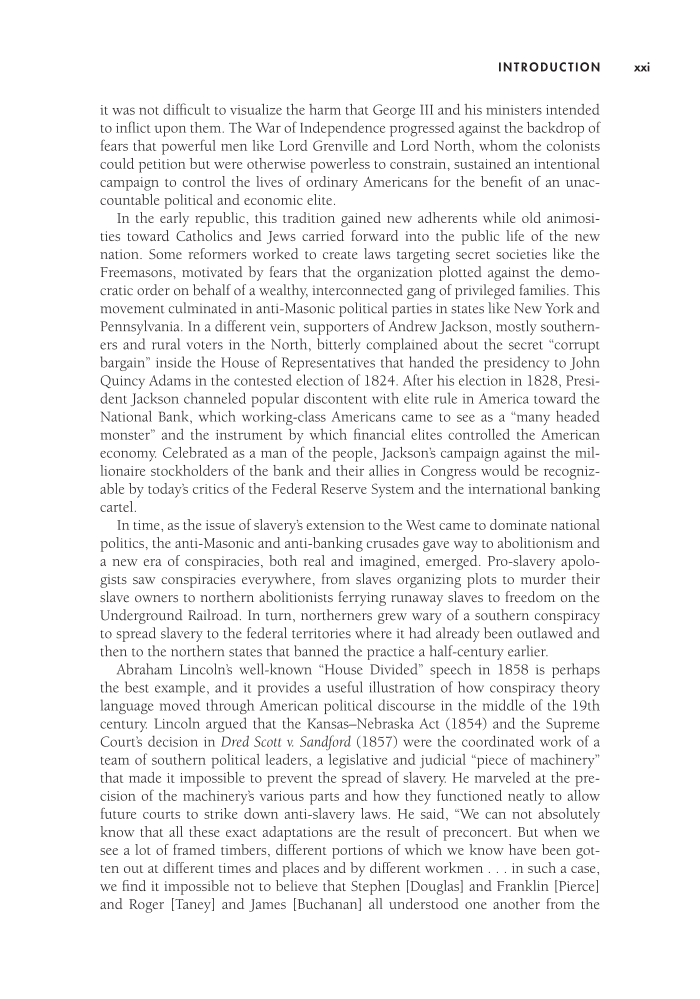Introduction xxi it was not difficult to visualize the harm that George III and his ministers intended to inflict upon them. The War of Independence progressed against the backdrop of fears that powerful men like Lord Grenville and Lord North, whom the colonists could petition but were otherwise powerless to constrain, sustained an intentional campaign to control the lives of ordinary Americans for the benefit of an unac- countable political and economic elite. In the early republic, this tradition gained new adherents while old animosi- ties toward Catholics and Jews carried forward into the public life of the new nation. Some reformers worked to create laws targeting secret societies like the Freemasons, motivated by fears that the organization plotted against the demo- cratic order on behalf of a wealthy, interconnected gang of privileged families. This movement culminated in anti-Masonic political parties in states like New York and Pennsylvania. In a different vein, supporters of Andrew Jackson, mostly southern- ers and rural voters in the North, bitterly complained about the secret “corrupt bargain” inside the House of Representatives that handed the presidency to John Quincy Adams in the contested election of 1824. After his election in 1828, Presi- dent Jackson channeled popular discontent with elite rule in America toward the National Bank, which working-class Americans came to see as a “many headed monster” and the instrument by which financial elites controlled the American economy. Celebrated as a man of the people, Jackson’s campaign against the mil- lionaire stockholders of the bank and their allies in Congress would be recogniz- able by today’s critics of the Federal Reserve System and the international banking cartel. In time, as the issue of slavery’s extension to the West came to dominate national politics, the anti-Masonic and anti-banking crusades gave way to abolitionism and a new era of conspiracies, both real and imagined, emerged. Pro-slavery apolo- gists saw conspiracies everywhere, from slaves organizing plots to murder their slave owners to northern abolitionists ferrying runaway slaves to freedom on the Underground Railroad. In turn, northerners grew wary of a southern conspiracy to spread slavery to the federal territories where it had already been outlawed and then to the northern states that banned the practice a half-century earlier. Abraham Lincoln’s well-known “House Divided” speech in 1858 is perhaps the best example, and it provides a useful illustration of how conspiracy theory language moved through American political discourse in the middle of the 19th century. Lincoln argued that the Kansas–Nebraska Act (1854) and the Supreme Court’s decision in Dred Scott v. Sandford (1857) were the coordinated work of a team of southern political leaders, a legislative and judicial “piece of machinery” that made it impossible to prevent the spread of slavery. He marveled at the pre- cision of the machinery’s various parts and how they functioned neatly to allow future courts to strike down anti-slavery laws. He said, “We can not absolutely know that all these exact adaptations are the result of preconcert. But when we see a lot of framed timbers, different portions of which we know have been got- ten out at different times and places and by different workmen . . . in such a case, we find it impossible not to believe that Stephen [Douglas] and Franklin [Pierce] and Roger [Taney] and James [Buchanan] all understood one another from the
Document Details My Account Print multiple pages
Print
You have printed 0 times in the last 24 hours.
Your print count will reset on at .
You may print 0 more time(s) before then.
You may print a maximum of 0 pages at a time.





































































































































































































































































































































































































































































































































































































































































































































































































































































































